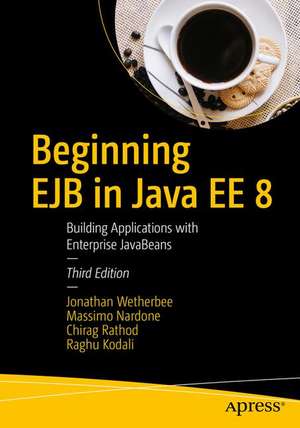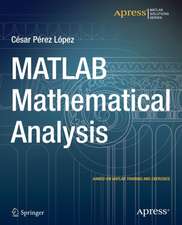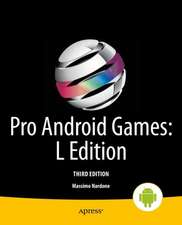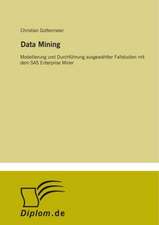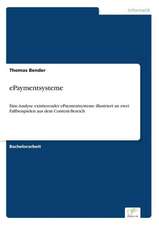Beginning EJB in Java EE 8: Building Applications with Enterprise JavaBeans
Autor Jonathan Wetherbee, Massimo Nardone, Chirag Rathod, Raghu Kodalien Limba Engleză Paperback – 26 mai 2018
Build powerful back-end business logic and complex Enterprise JavaBeans (EJB)-based applications using Java EE 8, Eclipse Enterprise for Java (EE4J), Web Tools Project (WTP), and the Microprofile platform. Targeted at Java and Java EE developers, with or without prior EJB experience, this book is packed with practical insights, strategy tips, and code examples. As each chapter unfolds, you'll see how you can apply the new EJB spec to your own applications through specific examples.
Beginning EJB in Java EE 8 serves not only as a reference, but also as a how-to guide and repository of practical examples to which you can refer as you build your own applications. It will help you harness the power of EJBs and take your Java EE 8 development to the next level. You'll gain the knowledge and skills you’ll need to create the complex enterprise applications that run today's transactions and more.
What You'll Learn
- Build applications with Enterprise JavaBeans (EJBs) in the new Java EE 8 platform
- Discover when to use EJBs over contexts and dependency injection
- Use message-driven beans to do tasks asynchronously
- Integrate EJBs with microservices using the new Eclipse Microprofile project
- Manage complex enterprise transactions and much more
Who This Book Is For
Java programmers new to enterprise development and for those who may have experience with EJBs but are new to Java EE 8, EE4J, and related Eclipse projects.
Preț: 439.28 lei
Preț vechi: 549.10 lei
-20% Nou
Puncte Express: 659
Preț estimativ în valută:
84.07€ • 87.44$ • 69.40£
84.07€ • 87.44$ • 69.40£
Carte disponibilă
Livrare economică 24 martie-07 aprilie
Preluare comenzi: 021 569.72.76
Specificații
ISBN-13: 9781484235720
ISBN-10: 148423572X
Pagini: 430
Ilustrații: XXX, 652 p. 193 illus.
Dimensiuni: 178 x 254 mm
Greutate: 1.17 kg
Ediția:3rd ed.
Editura: Apress
Colecția Apress
Locul publicării:Berkeley, CA, United States
ISBN-10: 148423572X
Pagini: 430
Ilustrații: XXX, 652 p. 193 illus.
Dimensiuni: 178 x 254 mm
Greutate: 1.17 kg
Ediția:3rd ed.
Editura: Apress
Colecția Apress
Locul publicării:Berkeley, CA, United States
Cuprins
1. Introduction to the EJB 3.2 Architecture & CDI Services.- 2. Session Beans.- 3. Entities and the Java Persistence API (JPA).- 4. Advanced Persistence Features.- 5. Message-Driven Beans.- 6. EJB and Microservices with Eclipse Microprofile.- 7. Integrating Session Beans, Entities, Message-Driven Beans, and Web Services.- 8. Transaction Management.- 9. EJB Performance and Testing.- 10. Context and Dependency Injection (CDI).- 11. Packaging and Deployment.- 12. EJB Client Applications.- 13. EJB Runtime Environments.
Notă biografică
Jonathan Wetherbee is a consulting engineer and tech lead for EJB development tools on Oracle's JDeveloper IDE. He has over 20 years of experience in development at Oracle, working on a variety of O/R mapping tools and overseeing Oracle's core EJB toolset since EJB 1.1. Most recently, Jon has been responsible for the design and development of EJB and JPA data binding solutions for ADF, Oracle's application development framework. Prior to joining the JDeveloper project, Jon was a product manager for Oracle's CASE (computer-aided software engineering) tools and worked on early object-relational frameworks. He received a patent in 1999 for his work on integrating relational databases in an object-oriented environment. Jon is coauthor of the first edition of this book, "Beginning EJB 3 Application Development: From Novice to Professional," and has published articles online in Java Developer's Journal and Oracle Technical Network. He enjoys speaking, and has given talks at conferences and developer groups, including Oracle's iDevelop (Bangalore, Taipei), The Server Side Java Symposium (Barcelona), and various Java user groups. Jon holds a Bachelor of Science degree in cognitive science from Brown University.
Massimo Nardone has more than 24 years of experiences in Security, Web/Mobile development, Cloud and IT Architecture. His true IT passions are Security and Android.
He has been programming and teaching how to program with Android, Perl, PHP, Java, VB, Python, C/C++ and MySQL for more than 20 years.
He holds a Master of Science degree in Computing Science from the University of Salerno, Italy.
He has worked as a Project Manager, Software Engineer, Research Engineer, Chief Security Architect, Information Security Manager, PCI/SCADA Auditor and Senior Lead IT Security/Cloud/SCADA Architect for many years.
Technical skills include: Security, Android, Cloud, Java, MySQL, Drupal, Cobol, Perl, Web and Mobile development, MongoDB, D3, Joomla, Couchbase, C/C++, WebGL, Python, Pro Rails, Django CMS, Jekyll, Scratch, etc.
He worked as visiting lecturer and supervisor for exercises at the Networking Laboratory of the Helsinki University of Technology (Aalto University). He holds four international patents (PKI, SIP, SAML and Proxy areas).
He currently works as Chief Information Security Office (CISO) for Cargotec Oyj and he is member of ISACA Finland Chapter Board. Massimo has reviewed more than 45 IT books for different publishers and additionally coauthoring this JPA book he is also the coauthor of Pro Android Games (Apress, 2015).
Raghu R. Kodali is a consulting product manager and service-oriented architecture (SOA) evangelist for Oracle Application Server. He has worked in the software industry for over 10 years as a developer, consultant, and presales engineer in emerging technologies. He is responsible for J2EE features with expertise in SOA technologies like EJB, Web Services, and application development frameworks. Raghu has been the lead product manager for EJB design-time features in Oracle JDeveloper since the EJB 1.1 specification. His current area of focus is evangelizing service-oriented infrastructure and implementing service-oriented applications. Prior to product management, Raghu held presales and marketing positions in Oracle Asia Pacific. Before joining Oracle, he worked as a software developer in Singapore. Raghu is frequent presenter at number of technology conferences such as Oracle Open World, Java One, Java Zone, JAOO, and Sun Technology Days. He holds a master's degree in computer applications.
Chirag Rathod is an IT trainer, technical writer with expertise in Java EE, Oracle NetBeans and related. He worked for Oracle's Fusion Middleware teamas Principle Member Technical Staff. He has 15 years of software development experience in Middleware and Development Tools; 14 years of service with Oracle Corporation (India).
Textul de pe ultima copertă
Build powerful back-end business logic and complex Enterprise JavaBeans (EJB)-based applications using Java EE 8, Eclipse Enterprise for Java (EE4J), Web Tools Project (WTP), and the Microprofile platform. Targeted at Java and Java EE developers, with or without prior EJB experience, this book is packed with practical insights, strategy tips, and code examples. As each chapter unfolds, you'll see how you can apply the new EJB spec to your own applications through specific examples.
Beginning EJB in Java EE 8 serves not only as a reference, but also as a how-to guide and repository of practical examples to which you can refer as you build your own applications. It will help you harness the power of EJBs and take your Java EE 8 development to the next level. You'll gain the knowledge and skills you’ll need to create the complex enterprise applications that run today's transactions and more.
You will:
- Build applications with Enterprise JavaBeans (EJBs) in the new Java EE 8 platform
- Discover when to use EJBs over contexts and dependency injection
- Use message-driven beans to do tasks asynchronously
- Integrate EJBs with microservices using the new Eclipse Microprofile project
- Manage complex enterprise transactions and much more
Caracteristici
Shows how to get started with EJBs for enterprise applications Explains the differences between EJBs and contexts and dependency injection and when to use each Includes how EJBs in Java EE 8 can be used with new Eclipse projects including Eclipse Enterprise for Java (EE4J), Web Tools Project (WTP) and the Microprofile project
